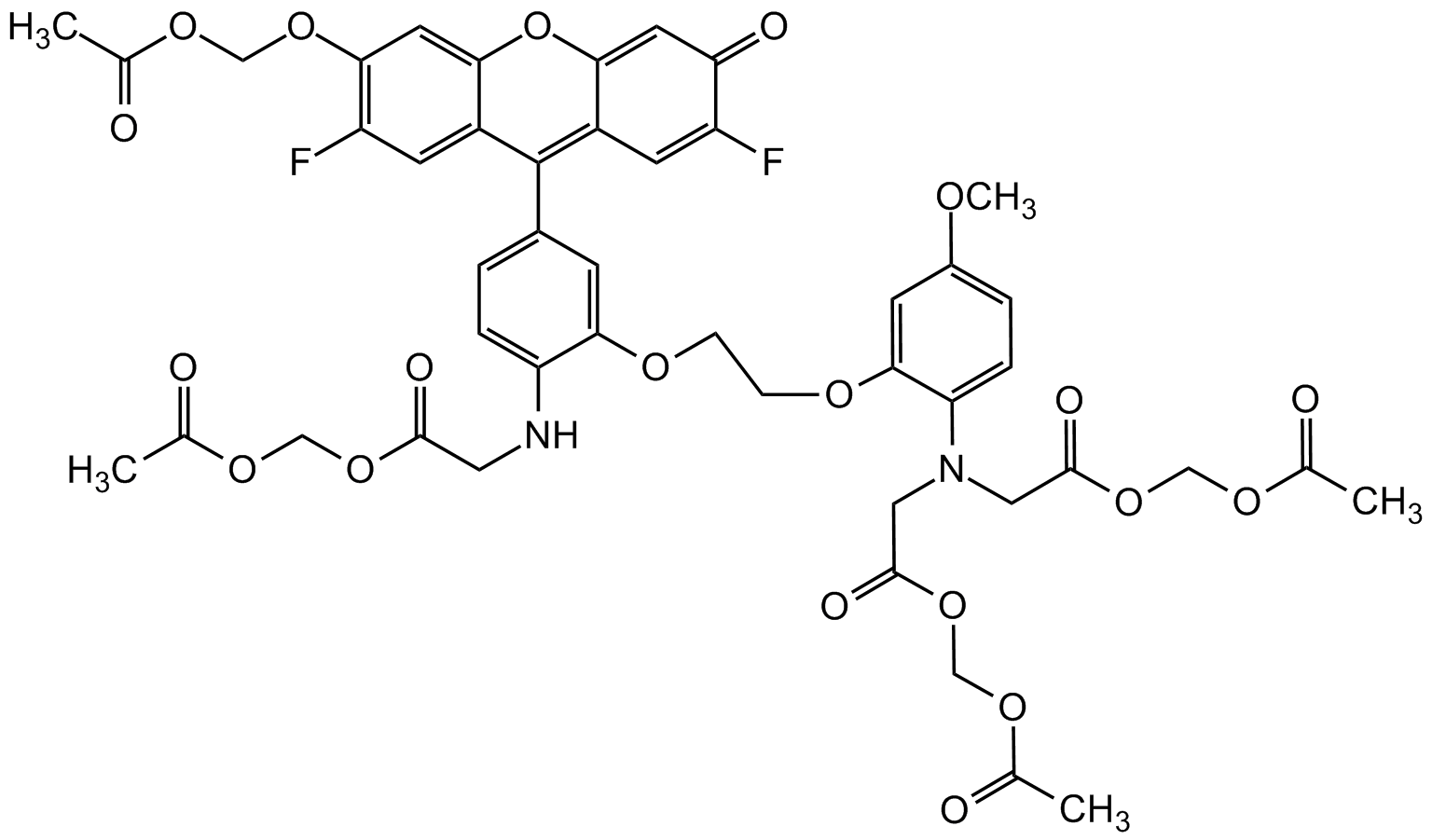Zin3 AM
| Code | Size | Price |
|---|
| CDX-F0019-C100 | 100 ug | £255.00 |
Quantity:
| CDX-F0019-C500 | 500 ug | £987.00 |
Quantity:
| CDX-F0019-M001 | 1 mg | £1,720.00 |
Quantity:
Prices exclude any Taxes / VAT
Overview
Regulatory Status: RUO
Shipping:
AMBIENT
Storage:
-20°C
Images
Documents
Further Information
Alternate Names/Synonyms:
FluoZin-3 AM (Registered Trademark of ThermoFisher)
Appearance:
Orange to red solid.
CAS:
562102-46-9
EClass:
32160000
Form (Short):
liquid
Handling Advice:
Protect from light and moisture.
InChi:
InChI=1S/C46H44F2N2O20/c1-25(51)62-21-66-40-17-39-32(15-34(40)48)46(31-14-33(47)37(55)16-38(31)70-39)29-6-8-35(49-18-43(56)67-22-63-26(2)52)41(12-29)60-10-11-61-42-13-30(59-5)7-9-36(42)50(19-44(57)68-23-64-27(3)53)20-45(58)69-24-65-28(4)54/h6-9,12-17,49H,10-11,18-24H2,1-5H3
InChiKey:
KMLHLVARODXKDJ-UHFFFAOYSA-N
Long Description:
Chemical. CAS: 562102-46-9. Formula: C46H44F2N2O20. MW: 982.85. Synthetic. Zin3 AM is a cell-permeable Zn2+-selective indicator (Absorption=456nm), that once it enters the cell is hydrolized by esterases to convert the bright fluorescent Zin3 (Ex/Em: ~494/516nm). Zin3 is suitable for detection of Zn2+ concentrations in the 1?100 nM range and it has shown to be very Zn2+-sensitive and Zn2+-specific. The cell permeant AM-ester is useful for detecting low intracellular Zn2+ levels and small concentration changes. Zin3 exhibits high Zn2+-binding affinity that is unperturbed by Ca2+ concentrations up to at least 1 µM (Kd (Zn2+) (in buffer): ~15nM). In addition, Zin3 exhibits a >50-fold increase in fluorescence in response to saturating levels of Zn2+. This dye is usedpredominantly for imaging applications, but has also used in cell-based microplate assays and flow cytometry protocols. The product is typically loaded into cells by adding the dissolved indicator to medium containing cells. Zinc is an important divalent cation in biological systems, influencing DNA synthesis, microtubule polymerization, gene expression, apoptosis, immune system function and the activity of enzymes such as carbonic anhydrase and matrix metalloproteinases (MMP). Zn2+ is also functionally active in synaptic transmission, and is a contributory factor in neurological disorders including epilepsy and Alzheimer?s disease.
Molecular Formula:
C46H44F2N2O20
Molecular Weight:
982.85
Package Type:
Vial
Product Description:
Zin3 AM is a cell-permeable Zn2+-selective indicator (Absorption=456nm), that once it enters the cell is hydrolized by esterases to convert the bright fluorescent Zin3 (Ex/Em: ~494/516nm). Zin3 is suitable for detection of Zn2+ concentrations in the 1?100 nM range and it has shown to be very Zn2+-sensitive and Zn2+-specific. The cell permeant AM-ester is useful for detecting low intracellular Zn2+ levels and small concentration changes. Zin3 exhibits high Zn2+-binding affinity that is unperturbed by Ca2+ concentrations up to at least 1 µM (Kd (Zn2+) (in buffer): ~15nM). In addition, Zin3 exhibits a >50-fold increase in fluorescence in response to saturating levels of Zn2+. This dye is usedpredominantly for imaging applications, but has also used in cell-based microplate assays and flow cytometry protocols. The product is typically loaded into cells by adding the dissolved indicator to medium containing cells. Zinc is an important divalent cation in biological systems, influencing DNA synthesis, microtubule polymerization, gene expression, apoptosis, immune system function and the activity of enzymes such as carbonic anhydrase and matrix metalloproteinases (MMP). Zn2+ is also functionally active in synaptic transmission, and is a contributory factor in neurological disorders including epilepsy and Alzheimer?s disease.
Purity:
>85% (HPLC)
SMILES:
O=C1C(F)=CC2=C(C3=CC=C(NCC(OCOC(C)=O)=O)C(OCCOC4=CC(OC)=CC=C4N(CC(OCOC(C)=O)=O)CC(OCOC(C)=O)=O)=C3)C5=CC(F)=C(OCOC(C)=O)C=C5OC2=C1
Solubility Chemicals:
Soluble in DMSO or methanol.
Source / Host:
Synthetic.
Transportation:
Non-hazardous
UNSPSC Category:
Fluorescent Reagents
UNSPSC Number:
41105331
Use & Stability:
Stable for at least 2 years after receipt when stored at -20°C.
References
(1) K.R. Gee, et al.; Cell Calcium 31, 245 (2002) | (2) K.R. Gee, et al.; JACS 124, 776 (2002) | (3) W.J. Qian, et al.; Biotechniques 37, 922 (2004) | (4) M.J. Devinney, et al.; Cell Calcium 37, 225 (2005) | (5) F.A. Muylle, et al.; Biometals 19, 437 (2006) | (6) H. Haase, et al.; Anal. Biochem. 352, 222 (2006) | (7) Z.L. Datki, et al.; Brain Res. Bull. 74, 183 (2007) | (8) J. Zhao, et al.; Cell Calcium 44, 422 (2008) | (9) J. Zhao, et al.; Anal. Biochem. 384, 34 (2009) | (10) Y.M. Li, et al.; Cell Biochem. Funct. 27, 417 (2009) | (11) M.A. Namdarghanbari, et al.; J. Inorg. Biochem. 104, 224 (2010) | (12) R.W. Sabnis; Handbook of biological dyes and stains (2010) | (13) I. Marszalek, et al.; J. Inorg. Biochem. 161, 107 (2016) | (14) I. Marszalek, et al.; Inorg. Chem. 57, 9826 (2019) | (15) L.M. Malaiyandi, et al.; Biometals (Epub ahead of print) (2019)



